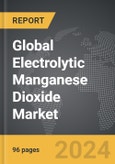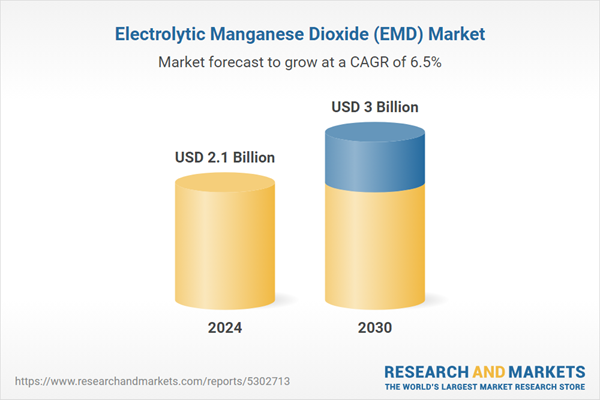Global Electrolytic Manganese Dioxide (EMD) Market - Key Trends & Drivers Summarized
Why Is Electrolytic Manganese Dioxide (EMD) Critical for Energy Storage and Electronics?
Electrolytic Manganese Dioxide (EMD) is a crucial material used as a cathode component in batteries, particularly in primary batteries like alkaline batteries and secondary batteries like lithium-ion and zinc-carbon batteries. Known for its high purity and superior electrochemical properties, EMD provides the necessary performance characteristics for battery applications, including high energy density, stability, and long lifecycle. In the battery industry, EMD's ability to enable efficient energy discharge and recharge cycles makes it ideal for consumer electronics, electric vehicles (EVs), and energy storage systems. As global demand for sustainable and efficient energy solutions increases, the role of EMD in battery technology becomes essential, supporting the rapid growth of portable electronic devices, renewable energy storage, and electric mobility.EMD's purity and structural stability provide excellent electrical conductivity and longevity in battery systems, which are especially critical in applications like electric vehicles where reliability and energy efficiency are paramount. The shift toward greener technologies and the increasing adoption of renewable energy storage solutions further emphasize EMD's importance, as it enables rechargeable batteries to store energy generated from renewable sources, such as solar and wind. This eco-friendly and high-performance material has positioned EMD as a core component of the energy storage industry, driving significant demand in both developed and emerging markets.
How Are Technological Innovations Shaping the EMD Market?
Technological advancements in the production and application of EMD are enhancing its performance, cost-efficiency, and applicability in a range of battery chemistries. One key innovation is the development of high-purity EMD grades specifically designed for high-performance batteries, such as those used in electric vehicles and grid storage. These high-purity EMD variants have enhanced stability and conductivity, reducing the risk of battery degradation over time. Additionally, advancements in nanostructured EMD are contributing to improved surface area and porosity, which facilitate faster ion transfer and increase battery capacity and efficiency. Nanostructuring also supports the development of high-energy-density batteries, making EMD suitable for next-generation lithium-ion and lithium-manganese batteries.Automation and improvements in electrolysis techniques have optimized EMD production, increasing efficiency, reducing energy costs, and minimizing waste. These production advancements make EMD manufacturing more environmentally friendly and cost-effective, expanding its market potential. Furthermore, research into hybrid battery systems, such as lithium-manganese oxide (LMO) and lithium-nickel-manganese-cobalt oxide (NMC) chemistries, is expanding the use of EMD beyond traditional applications. Together, these technological innovations are enhancing the performance and versatility of EMD, supporting its growth across diverse energy storage solutions, from consumer electronics to large-scale grid applications.
What Are the Key Applications of Electrolytic Manganese Dioxide?
The primary application of EMD is in battery manufacturing, where it serves as an essential cathode material for alkaline, zinc-carbon, and lithium-ion batteries. Alkaline batteries, widely used in consumer electronics like remote controls, flashlights, and toys, rely on EMD's high electrochemical stability and energy density to deliver consistent performance and extended shelf life. In lithium-ion batteries, EMD is used in lithium-manganese oxide (LMO) cathodes, which are known for their safety, stability, and long lifecycle, making them ideal for applications in electric vehicles, portable electronics, and renewable energy storage.Beyond the battery sector, EMD is also used in water treatment, where its catalytic properties aid in removing contaminants such as iron and hydrogen sulfide, improving water quality in industrial and municipal settings. EMD's oxidation potential makes it valuable in applications that require efficient oxidation reactions, such as the treatment of wastewater. Additionally, EMD is finding applications in the production of ferrites, which are magnetic materials used in electronic devices, and in some specialized ceramic and glass manufacturing processes. These diverse applications demonstrate the versatility and industrial importance of EMD, particularly in energy storage and environmental technologies.
What Is Driving Growth in the EMD Market?
The growth in the EMD market is driven by several key factors, including the increasing demand for batteries in consumer electronics, the expansion of electric vehicle production, advancements in energy storage technology, and rising environmental awareness. The rapid growth of the global electronics industry, with increasing demand for portable devices such as smartphones, laptops, and wearable devices, has spurred significant demand for reliable and efficient batteries. EMD's role in enabling high-energy-density and long-lasting batteries makes it a vital component in this expanding market.The transition toward electric mobility is another major growth driver, as electric vehicles require high-performance batteries with extended lifecycles and energy efficiency. Automakers worldwide are investing in lithium-ion and lithium-manganese battery technologies, further increasing the demand for EMD as a cathode material. Technological innovations in battery chemistries, such as lithium-manganese oxide (LMO) and lithium-nickel-manganese-cobalt oxide (NMC), are broadening EMD's applications, positioning it as a core material in advanced battery manufacturing.
Environmental concerns and regulatory pressures are also promoting the adoption of EMD, as it supports clean energy storage solutions that reduce carbon emissions. The use of EMD in renewable energy storage applications, such as solar and wind energy, aligns with global efforts to promote sustainability and reduce reliance on fossil fuels. Additionally, improvements in EMD production methods have made it more cost-effective and environmentally friendly, increasing its appeal across industries. Together, these factors - rising demand for energy storage, electric mobility expansion, regulatory incentives, and technological advancements - are driving robust growth in the EMD market, making it a foundational material for the future of sustainable energy and storage solutions.
Report Scope
The report analyzes the Electrolytic Manganese Dioxide (EMD) market, presented in terms of market value (US$ Thousand). The analysis covers the key segments and geographic regions outlined below.- Segments: Application (Batteries, Water Treatment, Other Applications).
- Geographic Regions/Countries:World; United States; Canada; Japan; China; Europe (France; Germany; Italy; United Kingdom; Spain; Russia; and Rest of Europe); Asia-Pacific (Australia; India; South Korea; and Rest of Asia-Pacific); Latin America (Argentina; Brazil; Mexico; and Rest of Latin America); Middle East (Iran; Israel; Saudi Arabia; United Arab Emirates; and Rest of Middle East); and Africa.
Key Insights:
- Market Growth: Understand the significant growth trajectory of the Batteries Application segment, which is expected to reach US$2.7 Billion by 2030 with a CAGR of a 6.6%. The Water Treatment Application segment is also set to grow at 5.8% CAGR over the analysis period.
- Regional Analysis: Gain insights into the U.S. market, valued at $536.3 Million in 2024, and China, forecasted to grow at an impressive 9.6% CAGR to reach $694.2 Million by 2030. Discover growth trends in other key regions, including Japan, Canada, Germany, and the Asia-Pacific.
Why You Should Buy This Report:
- Detailed Market Analysis: Access a thorough analysis of the Global Electrolytic Manganese Dioxide (EMD) Market, covering all major geographic regions and market segments.
- Competitive Insights: Get an overview of the competitive landscape, including the market presence of major players across different geographies.
- Future Trends and Drivers: Understand the key trends and drivers shaping the future of the Global Electrolytic Manganese Dioxide (EMD) Market.
- Actionable Insights: Benefit from actionable insights that can help you identify new revenue opportunities and make strategic business decisions.
Key Questions Answered:
- How is the Global Electrolytic Manganese Dioxide (EMD) Market expected to evolve by 2030?
- What are the main drivers and restraints affecting the market?
- Which market segments will grow the most over the forecast period?
- How will market shares for different regions and segments change by 2030?
- Who are the leading players in the market, and what are their prospects?
Report Features:
- Comprehensive Market Data: Independent analysis of annual sales and market forecasts in US$ Million from 2024 to 2030.
- In-Depth Regional Analysis: Detailed insights into key markets, including the U.S., China, Japan, Canada, Europe, Asia-Pacific, Latin America, Middle East, and Africa.
- Company Profiles: Coverage of players such as American Manganese Inc., Cegasa, CITIC Dameng, DAMENG, Delta EMD Ltd. and more.
- Complimentary Updates: Receive free report updates for one year to keep you informed of the latest market developments.
Some of the 48 companies featured in this Electrolytic Manganese Dioxide (EMD) market report include:
- American Manganese Inc.
- Cegasa
- CITIC Dameng
- DAMENG
- Delta EMD Ltd.
- Erachem
- Eveready
- Guizhou Redstar
- Huiyuan
- Mesa Minerals Limited (Mesa)
- Metallics Mine-chem Pvt. Ltd.
- Micromesh Minerals & Metals
- Moil
- Price International Corporation
- Qingdao BassTech Co., Ltd.
- Quintal
- Tosoh Corporation
- Tronox Limited
- Xiangtan Electrochemical Scientific Ltd.
This edition integrates the latest global trade and economic shifts into comprehensive market analysis. Key updates include:
- Tariff and Trade Impact: Insights into global tariff negotiations across 180+ countries, with analysis of supply chain turbulence, sourcing disruptions, and geographic realignment. Special focus on 2025 as a pivotal year for trade tensions, including updated perspectives on the Trump-era tariffs.
- Adjusted Forecasts and Analytics: Revised global and regional market forecasts through 2030, incorporating tariff effects, economic uncertainty, and structural changes in globalization. Includes historical analysis from 2015 to 2023.
- Strategic Market Dynamics: Evaluation of revised market prospects, regional outlooks, and key economic indicators such as population and urbanization trends.
- Innovation & Technology Trends: Latest developments in product and process innovation, emerging technologies, and key industry drivers shaping the competitive landscape.
- Competitive Intelligence: Updated global market share estimates for 2025, competitive positioning of major players (Strong/Active/Niche/Trivial), and refined focus on leading global brands and core players.
- Expert Insight & Commentary: Strategic analysis from economists, trade experts, and domain specialists to contextualize market shifts and identify emerging opportunities.
Table of Contents
Companies Mentioned (Partial List)
A selection of companies mentioned in this report includes, but is not limited to:
- American Manganese Inc.
- Cegasa
- CITIC Dameng
- DAMENG
- Delta EMD Ltd.
- Erachem
- Eveready
- Guizhou Redstar
- Huiyuan
- Mesa Minerals Limited (Mesa)
- Metallics Mine-chem Pvt. Ltd.
- Micromesh Minerals & Metals
- Moil
- Price International Corporation
- Qingdao BassTech Co., Ltd.
- Quintal
- Tosoh Corporation
- Tronox Limited
- Xiangtan Electrochemical Scientific Ltd.
Table Information
| Report Attribute | Details |
|---|---|
| No. of Pages | 189 |
| Published | December 2025 |
| Forecast Period | 2024 - 2030 |
| Estimated Market Value ( USD | $ 2.1 Billion |
| Forecasted Market Value ( USD | $ 3 Billion |
| Compound Annual Growth Rate | 6.5% |
| Regions Covered | Global |









